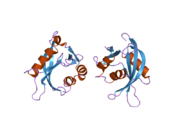Diphosphoinositol polyphosphate phosphohydrolase 2 is an enzyme that in humans is encoded by the NUDT4 gene.[5][6][7]
The protein encoded by this gene regulates the turnover of diphosphoinositol polyphosphates. The turnover of these high-energy diphosphoinositol polyphosphates represents a molecular switching activity with important regulatory consequences. Molecular switching by diphosphoinositol polyphosphates may contribute to regulating intracellular trafficking. Several alternatively spliced transcript variants have been described, but the full-length nature of some variants has not been determined. Isoforms DIPP2alpha and DIPP2beta are distinguishable from each other solely by DIPP2beta possessing one additional amino acid due to intron boundary skidding in alternate splicing.[7]
References
- ^ a b c GRCh38: Ensembl release 89: ENSG00000173598 – Ensembl, May 2017
- ^ a b c GRCm38: Ensembl release 89: ENSMUSG00000020029 – Ensembl, May 2017
- ^ "Human PubMed Reference:". National Center for Biotechnology Information, U.S. National Library of Medicine.
- ^ "Mouse PubMed Reference:". National Center for Biotechnology Information, U.S. National Library of Medicine.
- ^ Caffrey JJ, Safrany ST, Yang X, Shears SB (Jun 2000). "Discovery of molecular and catalytic diversity among human diphosphoinositol-polyphosphate phosphohydrolases. An expanding Nudt family". J Biol Chem. 275 (17): 12730–6. doi:10.1074/jbc.275.17.12730. PMID 10777568.
- ^ Caffrey JJ, Shears SB (May 2001). "Genetic rationale for microheterogeneity of human diphosphoinositol polyphosphate phosphohydrolase type 2". Gene. 269 (1–2): 53–60. doi:10.1016/S0378-1119(01)00446-2. PMID 11376937.
- ^ a b "Entrez Gene: NUDT4 nudix (nucleoside diphosphate linked moiety X)-type motif 4".
Further reading
- Maruyama K, Sugano S (1994). "Oligo-capping: a simple method to replace the cap structure of eukaryotic mRNAs with oligoribonucleotides". Gene. 138 (1–2): 171–4. doi:10.1016/0378-1119(94)90802-8. PMID 8125298.
- Suzuki Y, Yoshitomo-Nakagawa K, Maruyama K, et al. (1997). "Construction and characterization of a full length-enriched and a 5'-end-enriched cDNA library". Gene. 200 (1–2): 149–56. doi:10.1016/S0378-1119(97)00411-3. PMID 9373149.
- Seki N, Ohira M, Nagase T, et al. (1998). "Characterization of cDNA clones in size-fractionated cDNA libraries from human brain". DNA Res. 4 (5): 345–9. doi:10.1093/dnares/4.5.345. PMID 9455484.
- Leslie NR, McLennan AG, Safrany ST (2002). "Cloning and characterisation of hAps1 and hAps2, human diadenosine polyphosphate-metabolising Nudix hydrolases". BMC Biochem. 3: 20. doi:10.1186/1471-2091-3-20. PMC 117780. PMID 12121577.
- Fisher DI, Safrany ST, Strike P, et al. (2003). "Nudix hydrolases that degrade dinucleoside and diphosphoinositol polyphosphates also have 5-phosphoribosyl 1-pyrophosphate (PRPP) pyrophosphatase activity that generates the glycolytic activator ribose 1,5-bisphosphate". J. Biol. Chem. 277 (49): 47313–7. doi:10.1074/jbc.M209795200. PMID 12370170.
- Strausberg RL, Feingold EA, Grouse LH, et al. (2003). "Generation and initial analysis of more than 15,000 full-length human and mouse cDNA sequences". Proc. Natl. Acad. Sci. U.S.A. 99 (26): 16899–903. Bibcode:2002PNAS...9916899M. doi:10.1073/pnas.242603899. PMC 139241. PMID 12477932.
- Fortna A, Kim Y, MacLaren E, et al. (2006). "Lineage-Specific Gene Duplication and Loss in Human and Great Ape Evolution". PLOS Biol. 2 (7): E207. doi:10.1371/journal.pbio.0020207. PMC 449870. PMID 15252450.
- Gerhard DS, Wagner L, Feingold EA, et al. (2004). "The Status, Quality, and Expansion of the NIH Full-Length cDNA Project: The Mammalian Gene Collection (MGC)". Genome Res. 14 (10B): 2121–7. doi:10.1101/gr.2596504. PMC 528928. PMID 15489334.



Recent Comments